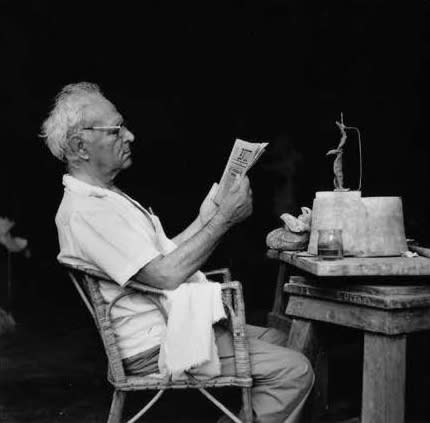"Those who do not believes in miracles are not realists".
Born in Barcelona in 1899, the sculptor Apel.les FENOSA left Spain for France in 1920. After staying in Toulouse, he settles in Paris in 1921. The same year, he meets Pablo Picasso who encourages him to persevere in sculpture and who will buy a significant number of his sculptures, thus becoming one of the first and principal collectors of FENOSA. In 1924, his first Parisian exhibit is prefaced by Max Jacob, who will also preface the exhibit of the Zborowski gallery, four years later.
In 1929, FENOSA returns to Barcelona where an exhibition of this work is being prepared. Caught by the Spanish Civil War (in which he is active on the Republican side), he remains in Catalonia until 1939. The Francoists victory forces him into exile. He returns to France where he will work until his death.
In 1944, the \Comite de Liberation du Limousin\ (Organization for the Liberation of the Limousin) orders a sculpture to commemorate the killings of Oradour-sur-Glane. He creates the "Monument aux Martyrs d'Oradour-sur-Glane" (Monument to the Martyrs of Oradour) presently in Limoges. After 1946, he exhibits individually or collectively in Paris, London, Barcelona, Madrid, Prague, New York, Tokyo, Osaka, Casablanca, Carrare...His personal exhibits are prefaced by the most famous writers and poets of his time, including Paul Eluard, Jean Cocteau, Jules Supervielle, Josep Carner, Alexandre Cirici-Pellicer, Francis Ponge, Pablo Neruda, Michel Cournot, Roger Caillois, Salvador Espriu...Populated with small sculptures, his work also includes a number of monumental pieces, as the "Christ" (1956-57) for the church of the Christ-Roi in Fribourg, Polyphème (1949) set in Dole since 1972, the "Sphinx" (1973) for the pediment of the door of the Constitutionnal Court in Paris, the "Monument to Pau Casals" (1976-77) set in Barcelona, the relief \Saint-Georges killing the dragon\ (1977) set in Paris, "Orlando Furioso" (1971-73) set in Madrid and Montpellier, the "Good Weather chasing the tempest" (1978-79) set in Barcelona and in Paris-La Défense, "Ophelia" (1951), bas-relief inspired by Rimbaud inaugurated in La Défense in 1987...In 1981, the UNESCO orders him a sculpture given every year to the laureate of the Unesco Price for Peace Education. Fenosa creates the "Olive Tree", symbol of peace and attribute of the poet. In 1982, he receives the Gold Medal of the Government of Catalonia, in 1983 the Legion d'Honneur and in 1987 the Gold Medal of Barcelona.
Large retrospectives were centered on FENOSA's work, in Madrid (National Library, 1979), Paris (Rodin Museum, 1980) and Barcelona (Palau de la Virreina, 1983-84).
Apel.les FENOSA died in Paris on March 25, 1988.
